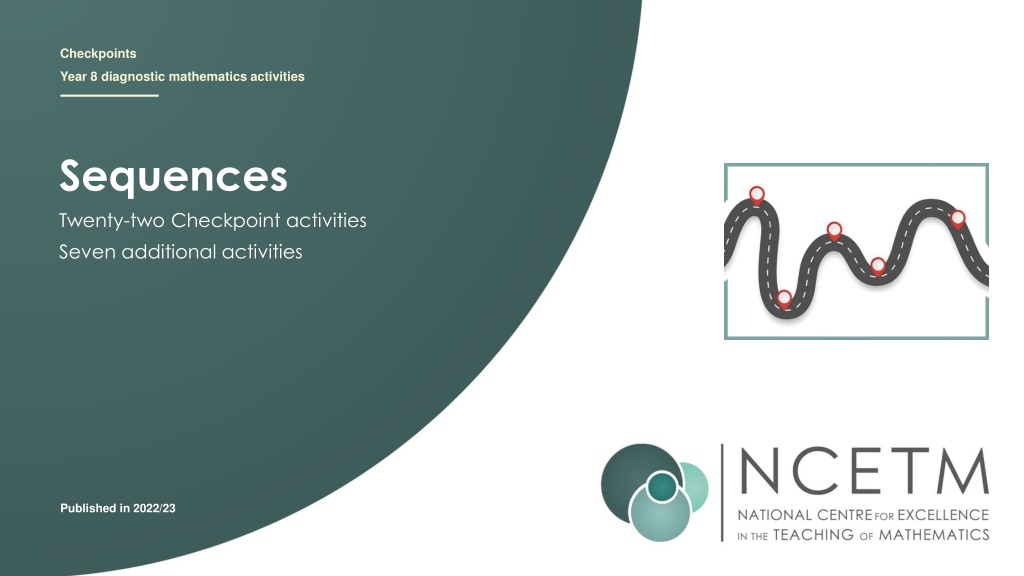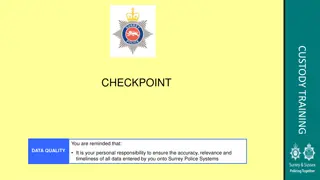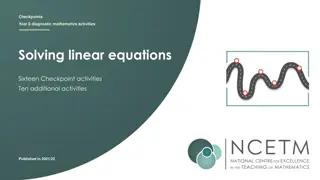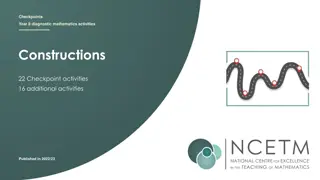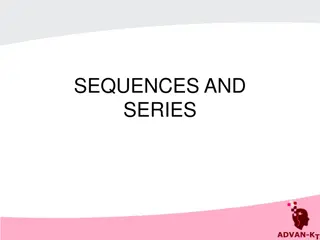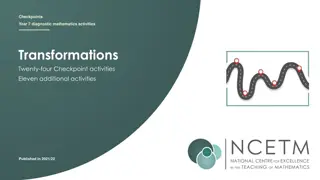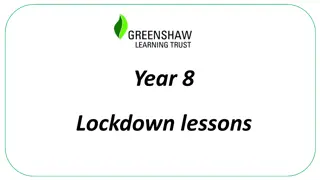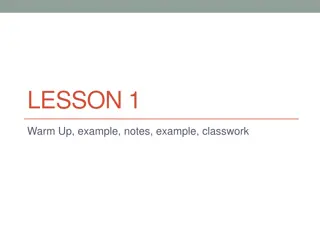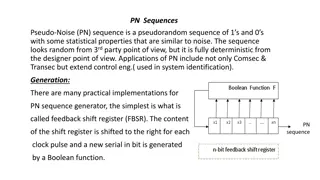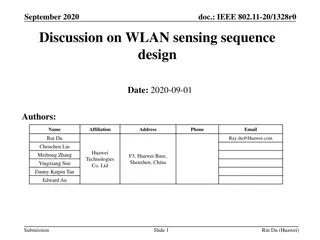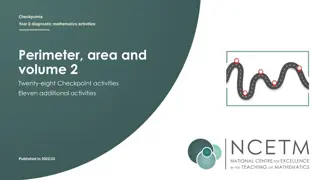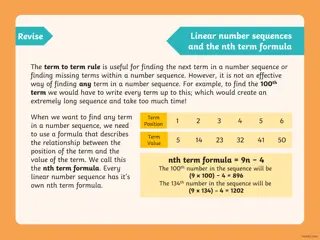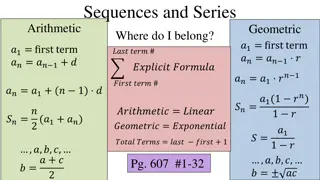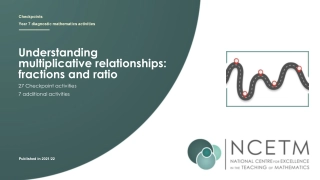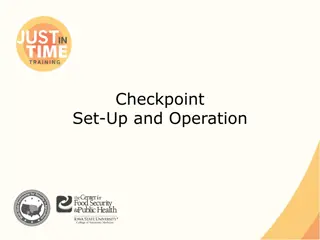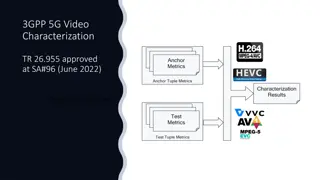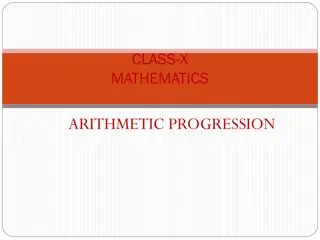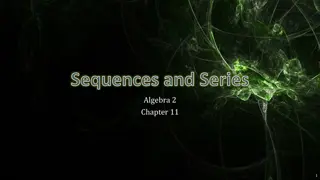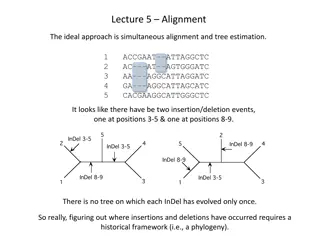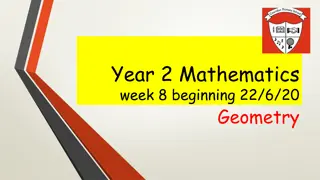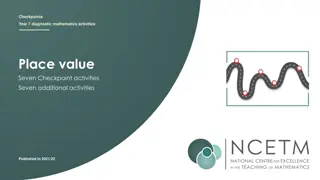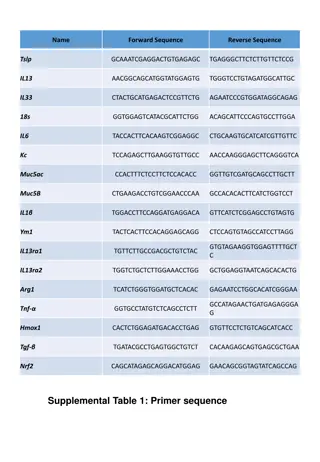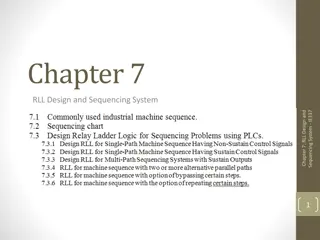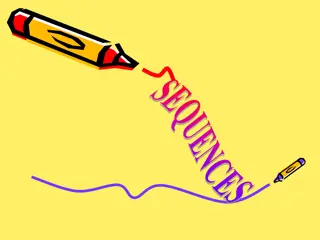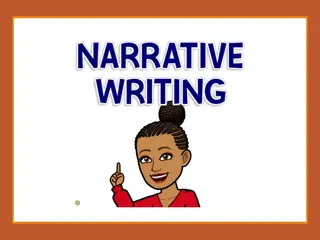Year 8 Mathematics Checkpoint Activities: Sequences & More
Dive into the diagnostic mathematics activities aimed at Year 8 students, focusing on sequences. The publication includes twenty-two Checkpoint activities with additional exercises, covering topics like adders, counting counters, same jump comparisons, and multiples. Explore the underpinnings of mathematical concepts with engaging challenges designed to enhance problem-solving skills.
Download Presentation

Please find below an Image/Link to download the presentation.
The content on the website is provided AS IS for your information and personal use only. It may not be sold, licensed, or shared on other websites without obtaining consent from the author. Download presentation by click this link. If you encounter any issues during the download, it is possible that the publisher has removed the file from their server.
E N D
Presentation Transcript
Checkpoints Year 8 diagnostic mathematics activities Sequences Twenty-two Checkpoint activities Seven additional activities Published in 2022/23
Checkpoints 18 Checkpoint Underpins Code 1: Adders 2: Counting counters 3: Same jump? 4: Multiples galore 4.1.1 4.1.2 The structure of patterns and sequences 5: Snapshots 6: Tell me all about it 7: 1, 3 8: Crossnumber *This three-digit code refers to the statement of knowledge, skills and understanding in the NCETM s Sample Key Stage 3 Curriculum Framework (see notes below for more information).
Checkpoints 916 Checkpoint 9: Which sequence? Underpins Code 10: Sequence jumble 4.1.1 4.1.2 The structure of patterns and sequences 11: Nine dots 12: School dinners 13: Tiles and holes 14: Patterns galore 4.1.1 4.1.2 Preparing for the nth term 15: Who gets there first? 16: Square patterns *This three-digit code refers to the statement of knowledge, skills and understanding in the NCETM s Sample Key Stage 3 Curriculum Framework (see notes below for more information).
Checkpoints 1722 Checkpoint 17: Hidden numbers Underpins Code 18: Left, right, up, down 19: Off the page 4.1.1 4.1.2 Preparing for the nth term 20: Four columns 21: More holes 22: Dice games *This three-digit code refers to the statement of knowledge, skills and understanding in the NCETM s Sample Key Stage 3 Curriculum Framework (see notes below for more information).
The structure of patterns and sequences Checkpoints 1 12
Checkpoint 1: Adders Some students are making a number pattern using a rule. Ahmed Betty Ahmed says any number, then Betty adds a number to it. Each person in turn then adds the same number that Betty added. a) If Ahmed says 5 and Betty says 7, then Chi will say 9, Darcy 11, and so on. What will Livy say? How do you know? b) After a different starting number, Betty says 23 and Chi says 26. What did Ahmed say? How do you know? c) Ahmed says 9 to start. Kay says 79. What will Livy say? How do you know? Chi Darcy Ezra Finn Greg Hannah Ivy Jo Kay Livy The students make a new pattern. Three of the numbers are 10, 22 and 34. Which students might have said these? What might the other children students have said?
Checkpoint 2: Counting counters Allyce and Billy are making a repeating pattern from different counters. 5 1 4 6 7 3 8 9 11 15 10 12 16 13 14 17 2 Allyce puts down three counters numbered 179, 180 and 181. a) What do Allyce s counters look like? How do you know? 18 19 20 Billy then puts down three counters in a row. Two are yellow squares and one is a red hexagon. All his counters are numbered over 250. b) What might the numbers on them be? How do you know? 21 22 Allyce and Billy run out of counters when they put down number 531. How many of each type of counter did they use in total? 23 24 25 26
Checkpoint 3: Same jump? Is it possible to fill in the missing numbers for these sequences? Why or why not? 1 5 a) 13 21 0.1 0.3 b) 28 16 4 c) 0 0.3 0.9 d) 4 3 2 e) For the ones that weren t possible, what could you change so that they are possible?
Checkpoint 4: Multiples galore Nicola is making patterns that go up in fours. Howard is making patterns that go up in threes. They show one image from each of their patterns. Which of these are Nicola s and which are Howard s? How do you know? E F H A B D C I G Create your own visual patterns going up in threes and fours. Could any of your images appear in both sequences?
Checkpoint 5: Snapshots When you click on each square, it will briefly reveal a pattern. A B C D How many dots are in each pattern? How do you know? Describe how you saw the pattern. E If each pattern was part of a different sequence, what might the next pattern be for each? What might the previous pattern have been?
Checkpoint 5: Snapshots (solutions) A B C D E How many dots are in each pattern? How do you know? Describe how you saw the pattern.
Checkpoint 5: Snapshots (solutions to further thinking question part 1) A A B
Checkpoint 5: Snapshots (solutions to further thinking question part 2) D E C
Checkpoint 6: Tell me all about it Create sentences to describe each of the sequences below, using one or more words from the box. You do not need to use all of the words and you can use the words more than once. a) 6, 15, 24, 33, 42 b) 101, 96, 91, 86, 81 c) 16, 8, 4, 2, 1 d) 1, 3, 6, 10, 15 e) 10 000, 1 000, 100, 10, 1, 0.1 f) 1, 4, 9, 16, 25 ascending descending increasing decreasing difference term ascending Can you describe any of the sequences using words that are not in the box?
Checkpoint 7: 1, 3 Gina writes down the first two terms of a sequence: 1, 3 a) What do you think the next two terms will be? Here are three different ways that Gina could have continued the sequence: 1, 3, 6, 10 1, 3, 5, 7 1, 3, 9, 27 b) What might Gina s rule for each option have been? c) Which sequence should Gina choose if she wants to: only have odd numbers reach 100 using the smallest number of terms include 45? Gina says the only numbers common to her sequences are 1 and 3. Are there any other numbers common to two of the sequences? How about all three?
Checkpoint 8: Crossnumber This puzzle is made from sequences where the same number is added or subtracted each time. Each sequence across or down has a different rule. Complete the puzzle and fill in the gaps to complete the rule for each sequence. Across B: Start at __ and + 3 each time. E: Start at 23 and __ each time. F: Start at __ and __ each time. Down A: Start at __ and __ each time. C: Start at __ and __ each time. D: Start at __ and __ each time. Continue sequences C and D. Write another clue across to connect them. Will it be the same as F?
Checkpoint 8: Crossnumber (solutions) This puzzle is made from sequences where the same number is added or subtracted each time. Each sequence across or down has a different rule. Complete the puzzle and fill in the gaps to complete the rule for each sequence. Across B: Start at 5 and + 3 each time. E: Start at 23 and + 6 each time. F: Start at 51 and - 1 each time. Down A: Start at -3 and + 8 each time. C: Start at 1 and + 10 each time. D: Start at 20 and + 7 each time.
Checkpoint 9: Which sequence? Below are the first four terms in four different sequences. A: 1, 4, 7, 10 ... For which sequences will these statements be true? Explain your reasoning. B: 4, 7, 10, 13 ... Has negative numbers. Has 1 in it. Has 4 in it. Is ascending. Has 19 in it. Has a difference of 3. Has 81 in it. Has 82 in it. C: 16, 13, 10, 7 ... D: 4, 1, -2, -5 ... Which of the statements are true for this sequence? 1, 3, 9, 27 ...
Checkpoint 10: Sequence jumble Kayla creates a sequence of numbers using equal steps. She writes one term per card, but then drops the cards! 23 1 2 31 5 4 4 2 a) Rearrange Kayla s cards with the terms in ascending order. b) What might be written on the upside-down cards? Kayla thinks the integer 4 is in the sequence. Is she correct? What other integers will be in the sequence?
Checkpoint 11: Nine dots These nine dots represent the third pattern in a sequence. a) What do you think the second pattern in the sequence could have looked like? b) Using your rule, what would the next pattern in the sequence be? c) Using your rule, how many dots would there be in the tenth pattern? d) Is there more than one possible answer? Iman has 27 dots in her answer to part b. Gaia has 16 dots in her answer to part b. What might their rules be? How many more dots will Iman have than Gaia in their fifth patterns?
Checkpoint 11: Nine dots (animated solution) These nine dots represent the third pattern in a sequence. Columns (3, 6, 9 ) Rows (3, 6, 9 ) Three possible previous patterns are shown; there are many others. Squares (1, 4, 9 )
Checkpoint 12: School dinners In a school dining hall, six chairs fit around one rectangular table. Below are four ways, A to D, to arrange four tables. B C A D a) Describe how you would work out the maximum number of chairs you can add for each different arrangement of tables. b) Mary adds two more tables to each of these arrangements. How many extra chairs could she add? Mary adds even more tables to one of the original arrangements. This means she adds twice the original number of chairs. Which arrangement has she added to? How many tables did she add?
Preparing for the nth term Checkpoints 13 22
Checkpoint 13: Tiles and holes A sequence of patterns is made from green tiles, each with four holes. a) How many green tiles are in the 3rd pattern? The 6th pattern? The 10th pattern? How many holes are there in the 3rd pattern? The 6th pattern? The 10th pattern? Describe in words the relationship between the number of tiles and the number of holes. b) c) 1st 2nd 3rd d) How does your answer to part c change if the sequence looks like the one on the bottom right of this slide instead? If a pattern has 217 holes, which of the two sequences is it from? Describe what the pattern looks like.
Checkpoint 14: Patterns galore a) What is the same and what is different about the four sequences A to D on the left? Describe the next pattern in each of A to D. What would the 10th pattern look like in each of A to D? What would the 13th pattern look like in each of A to D? What was the same and what was different about your answers to parts b, c and d? B A b) c) C d) e) D Design some other patterns that follow the same structure those in A to D.
Checkpoint 15: Who gets there first? Penny and James are writing different number patterns. Penny counts in steps of 4. James counts in steps of 3. Who will pass 20 first if: a) They both start at 0? b) Penny starts at 1 and James starts at 2? c) Penny starts at 1 and James starts at 11? d) Penny starts at 1 and James starts at 5? e) Penny starts at -1 and James starts at 4? What is the smallest difference needed for their starting numbers if James is going to pass 20 first? How about if they are to reach 20 at the same time?
Checkpoint 16: Square patterns Nawisah shades a number pattern in blue on the grid. She starts at 5. a) What can you say about the pattern? b) What will the next three numbers be after 45? c) Will 80 be in the number pattern? Why/why not? d) Ben starts a different pattern in orange stripes on the grid. Repeat questions a to c for his pattern. 1 2 3 4 5 6 7 8 9 10 11 12 13 14 15 16 17 18 19 20 21 22 23 24 25 26 27 28 29 30 31 32 33 34 35 36 37 38 39 40 41 42 43 44 45 46 47 48 49 50 e) Ben and Nawisah continue their patterns further down the grid. Have they shaded the correct numbers? How do you know? 81 82 83 84 85 86 87 88 89 90 91 92 93 94 95 96 97 98 99 100 Create your own pattern. Can you think of one that doesn t share any numbers with Nawisah or Ben s patterns?
Checkpoint 17: Hidden numbers Here is a 100 grid with most of the numbers hidden. Ben has shaded the multiples of 10. c) Dorian says he has used the same rule as Carla to colour in his squares. Do you agree? a) Carla says she has shaded the multiples of nine. Is she correct? Why or why not? b) How could Carla describe her numbers? Using the same grid, Eva thinks of a rule and shades two columns. What do you know about the rule she has chosen?
Checkpoint 18: Left, right, up, down 1 2 3 4 5 6 7 a) Describe the sequences created if you start at 31 (the green square) and move: left right 8 9 10 11 12 13 14 up down. 15 16 17 18 19 20 21 22 23 24 25 26 27 28 b) How would the sequences change if you moved the green square to a different place on the grid? c) How would the sequences change if the grid was eight squares across, rather than seven? 29 30 31 32 33 34 35 36 37 38 39 40 41 42 43 44 45 46 47 48 49 50 51 52 53 54 55 56 On a different grid, the red down arrow is placed over 25, 36 and 47. What can you tell about the grid? Where is the green square? Can you create a similar question about another grid?
Checkpoint 19: Off the page The pattern of numbers in this grid continues off the page. a) Which column will contain 60? How do you know? b) Which column will contain 119? How do you know? c) Ethan says all the numbers in the first (red) column are one more than a multiple of six. Is he correct? d) Describe the numbers in the second (yellow) column. e) Write down the numbers in the 100th row. 1 2 3 4 5 6 7 8 9 10 11 12 13 14 15 16 17 18 19 20 21 22 23 24 1 2 3 4 5 Ethan makes a new, similar pattern. Will any of the numbers be the same columns in this new grid as they were in the original grid? 6 7 8 9 10 11 12 13 14 15
Checkpoint 20: Four columns This array contains the numbers 1 40 in order but most of them are hidden. a) What do you notice about the numbers shaded yellow in the fourth column? b) Becky says, The numbers shaded red in the second column are all in the 2 times table. Is this a good way to describe them? c) Nic says, The numbers shaded blue in the first column are all one more than a multiple of 4. Is this a good way to describe them? d) Rachel says, The numbers shaded blue in the first column are all 3 less than a multiple of 4. Is this a good way to describe them? e) Richard says, The numbers shaded blue in the first column are all 5 more than a multiple of 4. Is this a good way to describe them? 1 2 Describe the numbers shaded purple in the third column. Is there more than one way to do this?
Checkpoint 21: More holes David and Sally are building sequences out of these tiles. They each choose two different types of tile. David s sequence: Sally s sequence: a) Describe how David has created his sequence. b) Describe how Sally has created her sequence. The sequences are both continued. c) If there are 41 holes, how many of each colour tile could there be? d) If there are 41 green tiles, how many holes could there be? There are only 19 green tiles available in total for both David and Sally to each make one of their patterns. Can they both make a pattern with the same number of holes?
Checkpoint 22: Dice games Two students are playing a game. They each write an algebraic expression. Cain writes 4n + 3. Steph writes 5n 2. They roll a ten-sided die (labelled 0 to 9) and use the score on the die to be the number, n, in their expression. The winner is the person whose expression has the highest value. a) If the number on the die is 2, who wins? b) If the number on the die is 9, who wins? c) Is it possible for Cain and Steph to draw? Who would you most expect to win? Explain why.
Additional activities Activities A I
Activity A: Same jump In each number line, fill in the missing values. 1 5 a) 17 29 9 0 0.9 1.8 2.1 b) 27 11 -1 3 c) 22 28 34 d) 4 3 2 e) Create your own sequence using the same jump each time. What is the minimum information you need to give?
Activity B: Morse code is a way of writing messages using dots and dashes. This is Morse code for the number 1: a) Do you have enough information to work out Morse code for the number 2 ? Why or why not? This is Morse code for the number 2: b) What do you think Morse code for 3, 4 and 5 might be? c) What do you predict might be Morse code for 6, 7, 8 and 9? 6: Here is some more Morse code. Use this to check your answers to parts b and c. How do you think you would signal the number 10 in Morse code? How about 75? 84? 111? 9: 0:
Activity B: (solutions for parts b and c) 1 2 3 4 5 6 7 8 9 0 Here is some more Morse code. Use this to check your answers to parts b and c. How do you think you would signal the number 10? How about 75? 84? 111?
Activity C: Twos Here are four sequences, all linked to the number two. Sufyan says, I think 6, 4, 2, 0, -2, ... is the odd sequence out because it is the only one that will have negative numbers. a) Do you agree? b) Can you think of a reason why each of the sequences could be described as the odd one out ? A: 2, 4, 6, 8, 10, B: 11, 9, 7, 5, 3, C: 2, 4, 8, 16, 32, D: 6, 4, 2, 0, -2, Can you design your own sequence with equal steps? How many terms do you need to reveal for someone to be able to continue the pattern?
Activity D: Bigger and bigger These sequences get bigger and bigger. a) Do you recognise any of the sequences? b) Which sequence gets bigger the quickest? Which gets bigger the slowest? c) Which sequence would: get you closest to 100 after five terms get you closest to 100 after eight terms be greater than 1000 after 10 terms be greater than 1000 after 20 terms? A: 1, 3, 6, 10 B: 1, 4, 9, 16 C: 1, 8, 27, 64 D: 1, 1, 2, 3, 5, 8 E: 1, 2, 4, 8 F: 1, 10, 100, 1000 Which sequence would have an odd 100th term? Which would have odd 100th and 101st terms?
Activity E: Number tiles Here is a sequence made using number tiles. a) Describe what you see. b) Describe what the next pattern in the sequence will look like. Here is another sequence made using number tiles. c) What is the same and what is different from the previous sequence? d) Describe what the next pattern in the sequence will look like. Describe to someone how to make these sequences using number frames. What about the 10th pattern in the sequence?
Activity F: School dinners In a school dining hall, six chairs fit around one rectangular table. Below are two ways, A and B, to arrange some tables. a) To work out how many chairs she needs, the caretaker multiplies the number of tables by six. Which arrangement does she intend to use? b) How could she work out the number of chairs for the other arrangement? A B What other ways can you arrange the four tables? Can you create an arrangement that uses eight tables and 36 chairs?
Activity G: More sequence jumble Kayla creates a sequence of numbers using equal steps. She writes one term per card, but then drops the cards! 3 4 21 1 4 5 4 4 a) Rearrange the sequence with the terms in ascending order. b) What might be written on the upside-down cards? Kayla thinks the number 3 is in the sequence. Is she correct? What integers will be in the sequence?
Activity H: Left, right, up, down again 1 2 3 4 5 6 7 a) What are the nth terms of the sequences that are created if you start at 31 (the green square) and move: left right 8 9 10 11 12 13 14 up down. 15 16 17 18 19 20 21 22 23 24 25 26 27 28 b) How would the nth terms change as the green square moves around the grid? c) How would the nth terms change as the grid changes? 29 30 31 32 33 34 35 36 37 38 39 40 41 42 43 44 45 46 47 48 49 50 51 52 53 54 55 56 On a new grid, the sequence for the red arrow is 13n + 60. What are the nth terms for the other arrows?
Activity I: Four more columns Alex s array Nia s array This array contains the numbers 1 to 40 in order but most of them are hidden. Nia shades two columns of her array. a) What do you know about the numbers shaded yellow in the fourth column? b) What can you do to work out the numbers shaded red in the second column? Alex shades his columns a bit differently. c) Is your answer to part b the same or different? 1 2 1 2 Create a similar arrangement of cells on a grid that has six columns. How would your answers change?
5 1 13 21 a) 0.1 0.3 b) 28 16 4 c) 0 0.3 0.9 d) 4 3 2 e)
This puzzle is made from sequences where the same number is added or subtracted each time. Each sequence across or down has a different rule. Complete the puzzle and fill in the gaps to complete the rule for each sequence. A C Across B D B: Start at __ and + 3 each time E: Start at 23 and ___ each time F: Start at __ and ___ each time Down A: Start at __ and ___ each time C: Start at __ and ___ each time D: Start at __ and ___ each time 5 8 E 23 41 F 48 Continue sequences C and D down. Could you add in another clue across to connect them? Will it be the same as F?
23 1 2 31 5 4 4 2 23 1 2 31 5 4 4 2 23 1 2 31 5 4 4 2 23 1 2 31 5 4 4 2
Pattern 1 Pattern 2 Pattern 3 Pattern 4 Pattern 1 Pattern 2 Pattern 3 Pattern 4
17 29 1 5 9 a) 0 0.9 1.8 2.1 b) 27 11 -1 3 c) 22 28 34 d) 4 3 2 e)
